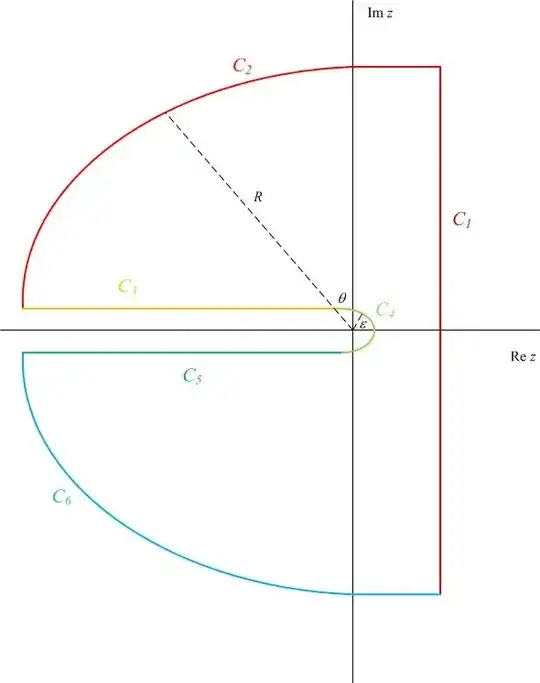This is a sort of heuristic approach, but it seems more straightforward to work with Laplace transforms and then extend the result to the given Fourier integral.
I reproduce the solution of the problem of finding the inverse Laplace transform of $e^{-\sqrt{s}}$, i.e.,
You can use a contour integration by deforming the Bromwich contour
about the negative real axis and exploiting a branch cut of $\sqrt{z}$
about that axis. So, consider the integral
$$\oint_C dz \: e^{-\sqrt{z}} e^{z t}$$
where $C$ is a keyhole contour about the negative real axis, as
pictured below.

We will define $\text{Arg}{z} \in (-\pi,\pi]$, so the branch is the
negative real axis. There are $6$ pieces to this contour, $C_k$, $k
> \in \{1,2,3,4,5,6\}$, as follows.
$C_1$ is the contour along the line $z \in [c-i R,c+i R]$ for some
large value of $R$.
$C_2$ is the contour along a circular arc of radius $R$ from the top
of $C_1$ to just above the negative real axis.
$C_3$ is the contour along a line just above the negative real axis
between $[-R, -\epsilon]$ for some small $\epsilon$.
$C_4$ is the contour along a circular arc of radius $\epsilon$ about
the origin.
$C_5$ is the contour along a line just below the negative real axis
between $[-\epsilon,-R]$.
$C_6$ is the contour along the circular arc of radius $R$ from just
below the negative real axis to the bottom of $C_1$.
We will show that the integral along $C_2$,$C_4$, and $C_6$ vanish in
the limits of $R \rightarrow \infty$ and $\epsilon \rightarrow 0$.
On $C_2$, the real part of the argument of the exponential is
$$R t \cos{\theta} - \sqrt{R} \cos{\frac{\theta}{2}}$$
where $\theta \in [\pi/2,\pi)$. Clearly, $\cos{\theta} \lt 0$ and
$\cos{\frac{\theta}{2}} \gt 0$, so that the integrand exponentially
decays as $R \rightarrow \infty$ and therefore the integral vanishes
along $C_2$.
On $C_6$, we have the same thing, but now $\theta \in (-\pi,-\pi/2]$.
This means that, due to the evenness of cosine, the integrand
exponentially decays again as $R \rightarrow \infty$ and therefore the
integral also vanishes along $C_6$.
On $C_4$, the integral vanishes as $\epsilon$ in the limit $\epsilon
\to 0$. Thus, we are left with the following by Cauchy's
integral theorem (i.e., no poles inside $C$):
$$\left [ \int_{C_1} + \int_{C_3} + \int_{C_5}\right] dz \:
e^{-\sqrt{z}} e^{z t} = 0$$
On $C_3$, we parametrize by $z=e^{i \pi} x$ and the integral along
$C_3$ becomes
$$\int_{C_3} dz \: e^{-\sqrt{z}} e^{z t} = e^{i \pi} \int_{\infty}^0
dx \: e^{-i \sqrt{x}} e^{-x t}$$
On $C_5$, however, we parametrize by $z=e^{-i \pi} x$ and the integral
along $C_5$ becomes
$$\int_{C_5} dz \: e^{-\sqrt{z}} e^{z t} = e^{-i \pi} \int_0^{\infty}
dx \: e^{i \sqrt{x}} e^{-x t}$$
We may now write
$$-\frac{1}{i 2 \pi} \int_0^{\infty} dx \: e^{- x t} \left ( e^{i
\sqrt{x}} - e^{-i \sqrt{x}} \right ) + \frac{1}{i 2 \pi} \int_{c-i
\infty}^{c+i \infty} ds \: e^{-\sqrt{s}} e^{s t} = 0$$
Therefore, the ILT of $\hat{f}(s) = e^{-\sqrt{s}}$ is given by
$$\begin{align}\frac{1}{i 2 \pi} \int_{c-i \infty}^{c+i \infty} ds \:
e^{-\sqrt{s}} e^{s t} &= \frac{1}{i 2 \pi} \int_0^{\infty} dx \: e^{-
x t} \left ( e^{i \sqrt{x}} - e^{-i \sqrt{x}} \right )\\ &=
\frac{1}{\pi} \int_{-\infty}^{\infty} du\: u \,e^{-t u^2}
\sin{u}\end{align}$$
The last step involved substituting $x=u^2$ and exploiting the
evenness of the integrand. This integral may be evaluated as follows:
$$\begin{align}\frac{1}{\pi} \int_{-\infty}^{\infty} du\: u \,e^{-t
u^2} \sin{u} &= \frac{1}{\pi} \Im{\left [\int_{-\infty}^{\infty}
du\:u\, e^{-t u^2} e^{i u} \right]}\\ &= \frac{1}{\pi} \Im{\left
[\int_{-\infty}^{\infty} du\:u\, e^{-t (u-i/(2 t))^2} e^{-1/(4
t)}\right ]}\\ &= \frac{1}{\pi} e^{-1/(4 t)} \Im{\left
[\int_{-\infty}^{\infty} dv \: \left ( v + \frac{i}{2 t} \right )
e^{-t v^2} \right]}\\ &= \frac{1}{\pi} e^{-1/(4 t)} \frac{1}{2 t}
\sqrt{\frac{\pi}{t}} \end{align}$$
Therefore the result is that
$$\mathcal{L}^{-1}[e^{-\sqrt{s}}](t) = \frac{1}{i 2 \pi} \int_{c-i
\infty}^{c+i \infty} ds \: e^{-\sqrt{s}} e^{s t} = \frac{1}{2
\sqrt{\pi}} t^{-3/2} e^{-\frac{1}{4 t}}$$
$$\frac1{2 \sqrt{\pi}} \int_0^{\infty} dx \, e^{-s x} e^{-\frac1{4 x}} x^{-3/2} = e^{-\sqrt{s}}$$
$$\frac1{\sqrt{2 \pi}} \int_0^{\infty} dx \, e^{-s x} e^{-\frac1{2 x}} x^{-3/2} = e^{-\sqrt{2 s}}$$
Now consider $s=-i k = e^{i 3 \pi/2} k$ for $k \gt 0$ and $s=+i k = e^{i \pi/2} k$ for $k \lt 0$. Then the stated result is reproduced.
